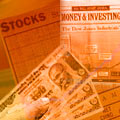Economic Survey - Domestic savings continue to rise
India can today boast of being among the top nations in terms of savings, which shot up to 32.4 per cent of GDP, but government or public savings declined to make a 'negative contribution'.
The quantum of savings gave the nation a much needed platform to raise the investment level, which touched 33.8 per cent, a fact that helped the economy to "take off from a phase of moderate growth to a new phase of high growth", the Economic Survey presented in Parliament said on Tuesday.
The quantum of savings gave the nation a much needed platform to raise the investment level, which touched 33.8 per cent, a fact that helped the economy to "take off from a phase of moderate growth to a new phase of high growth", the Economic Survey presented in Parliament said on Tuesday.
Public savings fell from 2.4 per cent of GDP in 2004-05 to two per cent the following year, despite savings of the public sector being in positive trajectory for the third successive year, the Survey said.
Public sector contributed Rs 71,262 crore in 2005-06 due to higher savings of both non-departmental as well as departmental enterprises, the Survey said.
A dramatic element in the savings profile of the Indian economy has been the sharp rise in the savings rate of the private sector for four years in a row. The private sector rate for 2005-06 has been pegged at 8.1 per cent, the Survey pointed out.
The sector has financed a large part of its investment in the ongoing long capital expenditure cycle from such retained earnings or savings.
Household savings continued to be the dominant contributor to gross domestic savings, accounting for 30.4 per cent of the total 32.4 per cent.
Within domestic investment, difference between gross fixed capital formation and changes in stocks narrowed, indicating a recent pick up in fresh investment for creating additional capacity through fixed capital formation, especially in private sector.
Two forces have been acting simultaneously on the portfolio behaviour of Indian households: A construction boom with residential buildings financed through housing loans from banks and the progressive maturing of the domestic financial markets, the Survey said.
While the construction boom has helped inflate household savings in physical form, the maturing markets have provided incentives for higher financial savings.
There was a perceptible shift in the household portfolio in the three years ending in 2005-06. Physical savings as a proportion of GDP has declined steadily from a high of 12.4 per cent in 2003-04 to 10.7 per cent in 2005-06.
Financial savings, on the other hand, after declining from 11.3 per cent to 10.2 per cent between 2003-04 and 2004-05, more than recovered to 11.7 per cent in 2005-06.
The increase in savings rate is what is to be expected with higher growth rate of the economy and a declining dependency ratio, according to the Survey.
With the proportion of population in the working age group of 15.64 years increasing steadily from 62.9 per cent in 2006 to 68.4 per cent in 2026, the demographic dividend in the form of high savings rate is likely to continue.
With savings rate going up, private final consumption expenditure at current prices as a proportion of GDP has shown a declining trend, particularly from 2001-02.

![[Most Recent Quotes from www.kitco.com]](http://www.kitconet.com/charts/metals/gold/t24_au_en_usoz_2.gif)



![[Most Recent Exchange Rate from www.kitco.com]](http://www.weblinks247.com/exrate/24hr-inr-small.gif)















No comments:
Post a Comment